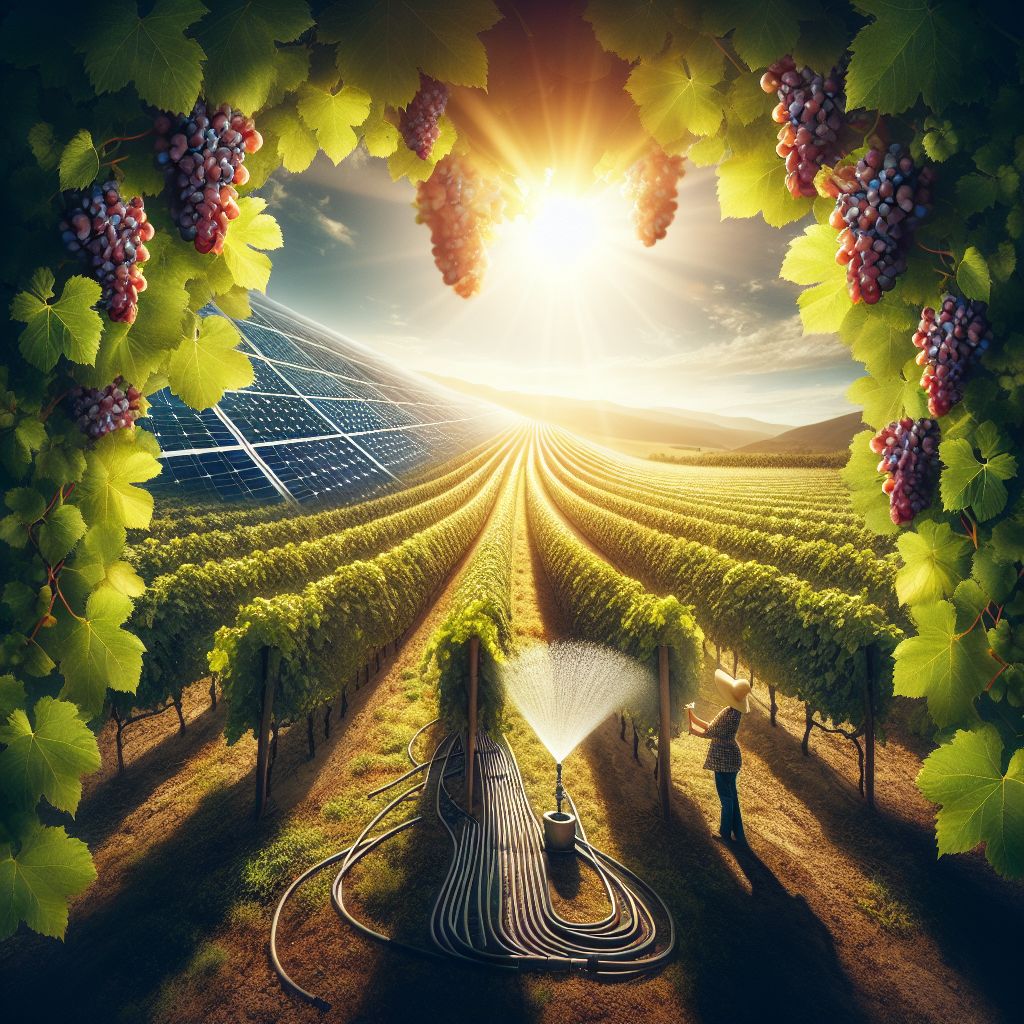
When it comes to cultivating grapes, water management is crucial. Every drop counts, and efficiency is the name of the game. That’s where solar irrigation systems come into play, providing grape growers with a sustainable and cost-effective way to nurture their vineyards. Let’s dive into the world of solar-powered irrigation and discover how it’s revolutionizing grape farming.
Key Takeaways
Solar irrigation systems can significantly reduce energy costs and increase sustainability in grape farming.
Drip irrigation is the most commonly used system in vineyards due to its efficiency and precision.
The initial investment in solar irrigation can be offset by long-term savings on water and energy bills.
Choosing the right type of solar panel is essential for meeting the specific energy needs of a vineyard’s irrigation system.
Despite the upfront costs, solar irrigation systems can provide a substantial return on investment through enhanced grape yield and quality.
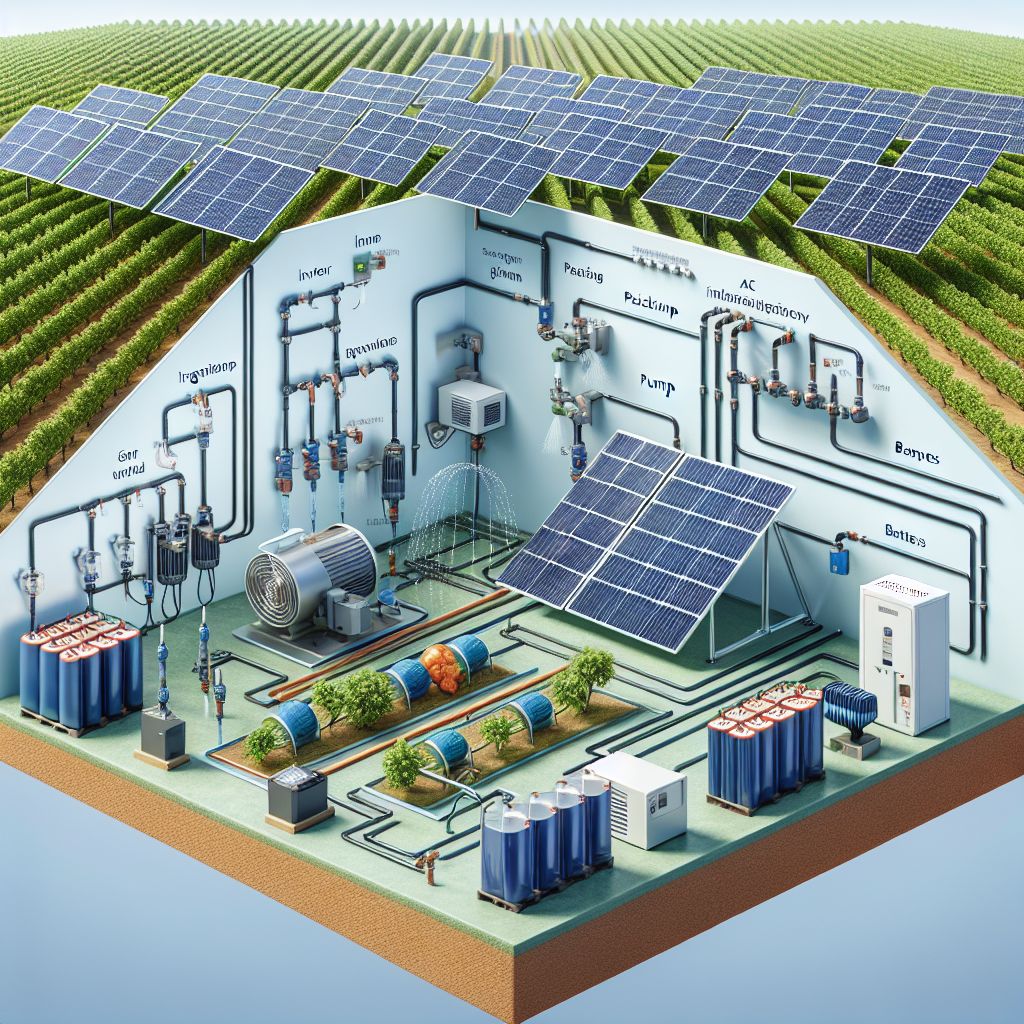
Why Combine Solar Panels with an Irrigation System
Imagine harnessing the power of the sun to water your vines—this isn’t just a dream, it’s a practical solution. By combining solar panels with an irrigation system, farmers can tap into a renewable energy source that’s both abundant and free. The benefits are clear: reduced reliance on the grid, lower energy bills, and a step towards a more sustainable farming practice.
Breaking Down Solar Irrigation
Wondering what solar irrigation is? It’s actually a system that uses photovoltaic panels to turn sunlight into electricity. This electricity then powers a pump that brings water from a source to your grapevines. You’ll need a few things to set this up: solar panels, a charge controller, batteries (to store energy), an inverter (if you’re using an AC pump), and the irrigation hardware.
So, why should you choose solar? It’s simple: it’s dependable, saves you money over time, and is better for the environment. Not only that, but it also allows you to cultivate in out-of-the-way places where connecting to the electricity grid might not be possible or economical.
Here’s what you need to get started:
A solar panel array: To capture and convert sunlight.
An inverter: To convert the solar energy into a form that can power the pump.
A water pump: To move water from your source to the vines.
Battery storage (optional): To store excess energy for use when sunlight isn’t available.
Irrigation infrastructure: Such as pipes, hoses, and emitters to deliver water to the plants.
Advantages of Integrating Solar Energy into Vineyard Irrigation
Switching to solar irrigation comes with a host of benefits:
Cost Savings: After the initial setup, the ongoing costs are minimal compared to conventional electricity or diesel-powered pumps.
Environmental Impact: Solar power is clean, reducing the carbon footprint of your vineyard operations.
Reliability: Solar systems are durable and require less maintenance than traditional systems.
Independence: Reduce your dependency on utility companies and the volatility of energy prices.
Therefore, by adopting solar irrigation, you’re not just saving money, you’re also investing in the future of your vineyard and the planet.
How Solar Irrigation Systems Work for Grapevines
Grapevines have specific watering needs, and a solar irrigation system can be tailored to meet those requirements. Drip irrigation, in particular, is perfect for delivering water directly to the base of each vine, minimizing waste and ensuring that each plant gets exactly what it needs to thrive.
Here’s how it works:
Solar panels collect sunlight and generate electricity.
The inverter converts the electricity to the right voltage for the pump.
The pump draws water from the source—be it a well, pond, or reservoir.
The water is delivered through a network of pipes and emitters, directly to the base of each vine.
Because solar panels only produce electricity when the sun is shining, many systems include a battery or are connected to the grid to ensure a consistent water supply. This setup allows for flexibility and ensures your vines stay hydrated, even on cloudy days or at night.
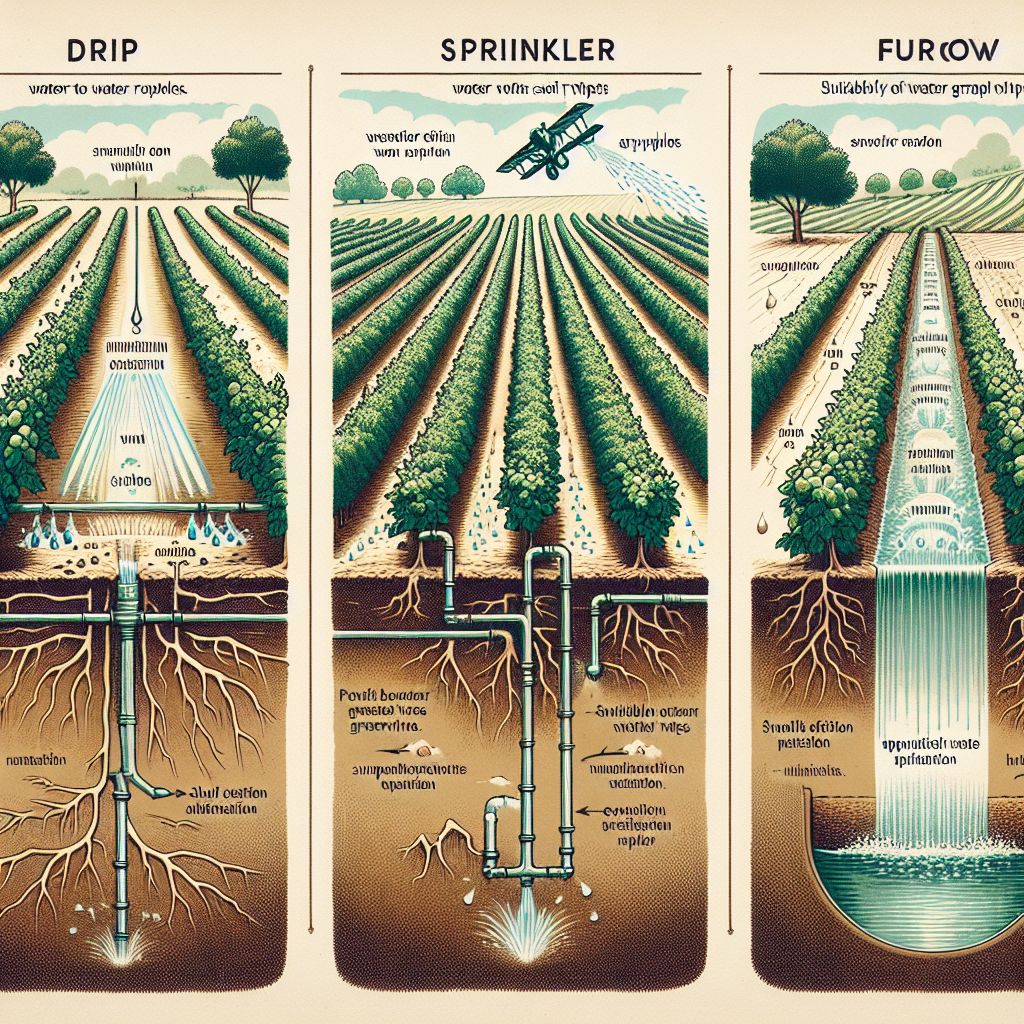
Different Irrigation Systems Used to Grow Grapes
Growing grapes, whether for wine, juice, or simply fresh fruit, requires careful attention to water management. Irrigation is crucial, but choosing the right system can be a challenge. This guide explores three popular irrigation methods: drip, sprinkler, and furrow, highlighting their effectiveness in different soil types.
Overview of Drip, Sprinkler, and Furrow Irrigation Methods
Drip Irrigation: A Targeted Approach. Drip irrigation delivers water directly to the roots of the grapevines through a network of tubes and emitters. This targeted approach offers several advantages:
Water Conservation: By applying water only where needed, drip irrigation minimizes evaporation and runoff, reducing water usage by up to 50% compared to other methods.
Nutrient Delivery: Fertilizers can be mixed with the irrigation water, ensuring efficient nutrient uptake by the vines.
Disease Prevention: Drip irrigation reduces humidity around the vines, minimizing the risk of fungal diseases.Sprinkler
Sprinkler Irrigation: A Wide-Spread Approach. Sprinkler irrigation applies water to the soil through overhead sprinklers. While less precise than drip irrigation, it offers a unique set of benefits:
Versatility: Suitable for a wide range of soil types, including clay and loam.
Cooling Effect: Sprinklers provide a cooling effect in hot climates, beneficial for grapevines.
Easy Installation: Relatively simple to set up and maintain.
Furrow Irrigation: A Traditional Approach. Furrow irrigation involves creating shallow trenches (furrows) between grapevine rows and flooding them with water. This method, while less efficient than drip or sprinkler, remains a popular choice in some regions:
Cost-Effective: Relatively low initial investment compared to other systems.
Simple Operation: Requires minimal specialized equipment.
Suitable for Large Areas: Can be used to irrigate large vineyards.
Choosing the Right Irrigation System
The best irrigation system for your vineyard depends on factors such as soil type, water availability, climate, and budget. Consider the following:
Soil type: Sandy soils require drip irrigation, while well-drained soils can benefit from sprinklers.
Water availability: Drip irrigation is ideal for water-scarce regions, while furrow irrigation is suitable where water is abundant.
Climate: Sprinklers can provide a cooling effect in hot climates.
Budget: Drip irrigation can have higher upfront costs but offers long-term savings.
Ultimately, the key is to choose a system that ensures optimal water management and promotes healthy grapevine growth. By understanding the strengths and weaknesses of each method, you can make an informed decision that will benefit your vineyard for years to come.
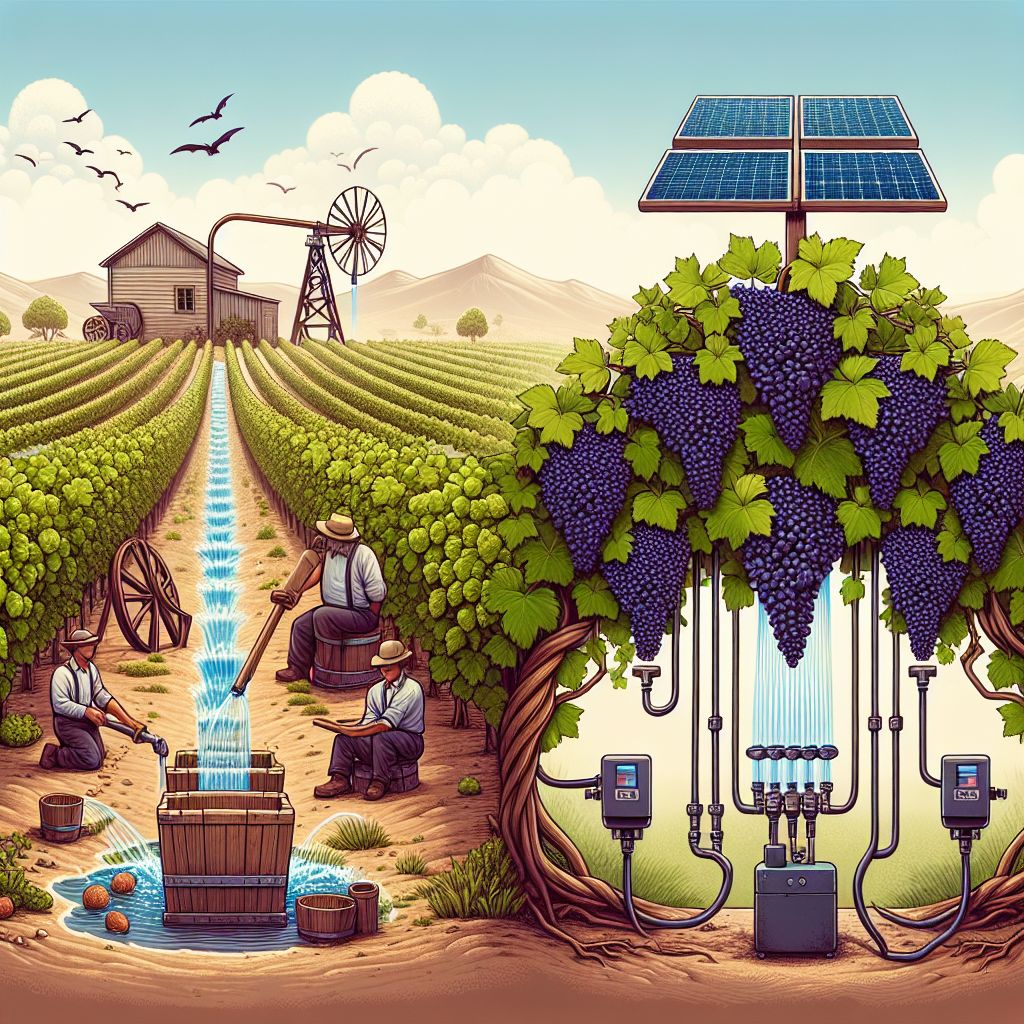
Cost and Increased Efficiency: Traditional Versus Modern Irrigation Systems for Growing Grapes
Irrigation is essential for maintaining optimal grapevine health and productivity. Traditional irrigation systems have been used for centuries, but modern irrigation technologies offer significant advantages in terms of cost and efficiency. Modern irrigation systems offer significant cost and efficiency advantages over traditional irrigation systems for growing grapes. While they may have a higher upfront cost, they provide long-term savings through increased yield, reduced operating costs, and improved environmental sustainability. By investing in modern irrigation technology, grape growers can enhance their profitability and ensure the future success of their vineyards.
Analyzing the Initial Costs and Long-Term Returns
Investing in solar irrigation may seem daunting at first glance. The upfront costs include purchasing solar panels, a pump, an inverter, and potentially batteries for storage. Depending on the size of your vineyard, this could range from a few thousand to tens of thousands of dollars. However, the long-term returns should be the focus here. Over time, the savings on energy bills will offset the initial investment. Moreover, many regions offer incentives or rebates for solar installations, which can significantly reduce upfront costs.
Impact of Efficient Water Management on Grape Yield and Quality
Efficient water management is not just about saving water; it’s about optimizing grape yield and quality. Vines that receive the right amount of water produce better fruit, which in turn leads to higher-quality wine. With solar irrigation, you have precise control over watering schedules, ensuring that vines get the perfect amount of moisture throughout their growth cycle. This precision leads to consistently better yields and can make all the difference in a competitive market.
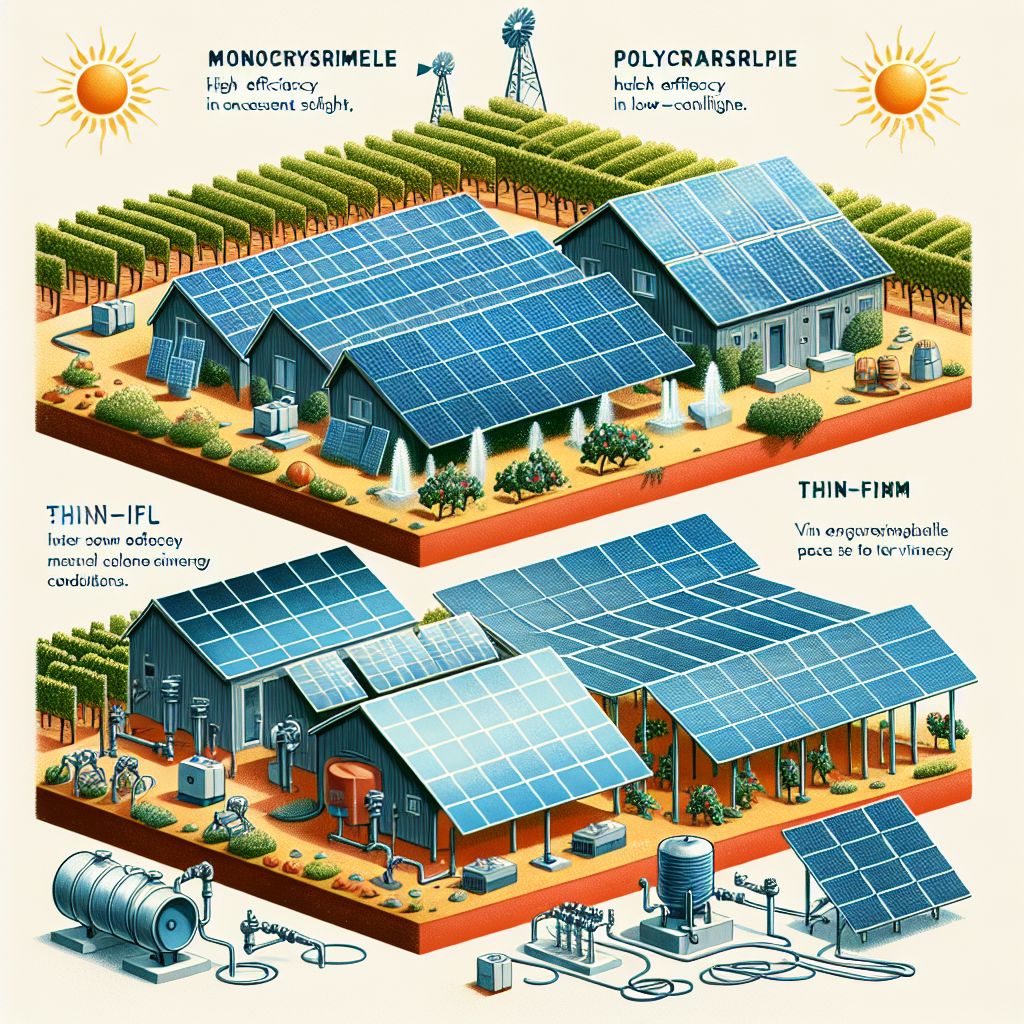
The Different Solar Panel You Can Add to the Irrigation System to Grow Grapes
Not all solar panels are created equal, and the choice you make will have a direct impact on the efficiency and effectiveness of your irrigation system. There are three main types of solar panels to consider: monocrystalline, polycrystalline, and thin-film. Each has its own advantages and suitability depending on your specific needs and environmental conditions.
Monocrystalline panels are highly efficient and perform well in low-light conditions, making them a good choice for areas with less consistent sunlight. Polycrystalline panels are generally less expensive but also less efficient. Thin-film panels are flexible and lightweight, making them easy to install on a variety of surfaces, but they require more space for the same energy output.
For example, a vineyard in a sunny region may opt for monocrystalline panels to maximize efficiency, while a vineyard with more space might choose the more affordable polycrystalline panels.
Choosing the right type of panel is critical to ensuring your system provides enough power to run your pumps and meet your irrigation needs.
Selecting Appropriate Solar Panels for Irrigation Power Needs
When selecting solar panels for your irrigation system, you must consider the power needs of your pump. The pump’s wattage will determine the size of the solar array required. It’s also essential to factor in the hours of sunlight your location receives and the water volume needed for your vines. An experienced solar installer can help you calculate the exact specifications for your system.
Matching Panel Types to Vineyard Size and Location
The size of your vineyard and its location play a significant role in determining the type of solar panel that will work best for you. Larger vineyards may require a more extensive solar array, while smaller operations might get by with fewer panels. Additionally, vineyards in areas with high sun exposure will benefit from different types of panels than those in less sunny climates.
Here’s a simple breakdown: for those interested in efficient watering solutions for vineyards.
Monocrystalline panels for high-efficiency needs in smaller or shaded vineyards.
Polycrystalline panels for a balance of cost and efficiency in moderate climates.
Thin-film panels for large, open vineyards where space is not an issue.
Understanding your vineyard’s specific conditions will guide you to the most suitable solar panel choice. Right below is a table looking at all the different solar panel options:
|
Solar Panel Type |
Efficiency Range |
Advantages |
Disadvantages |
|---|---|---|---|
|
Monocrystalline |
17-22% |
Highest efficiency, space-saving, long lifespan. 2 | |
|
Polycrystalline |
15-17% |
Lower efficiency, requires more space. 2 | |
|
Thin-Film |
10-13% |
Lightweight, flexible, good temperature coefficient. 2 |
Lowest efficiency, requires large area. 2 |
|
Portable Solar Panel Systems |
Varies based on panel type |
Designed for irrigation needs, easy to move and relocate. 1, 3 | |
|
Hybrid Solar Panels |
Varies based on components |
Can combine solar with other energy sources like wind, increased reliability. 4 |
More complex system, higher cost. 4 |
Monocrystalline panels provide the highest efficiency in a compact area but at a higher upfront cost (2, 3). Polycrystalline panels offer a balance of efficiency and cost (2, 3). Thin-film panels have lower efficiency but perform better in high temperatures (2). Portable solar panel irrigation systems allow flexibility in placement and relocation as needed (1). Hybrid systems increase reliability by combining solar with other renewable sources but add complexity (4). The optimal choice depends on factors like available space, budget, local climate conditions, and specific irrigation requirements for grapes.

Cost and Increased Efficiency: Regular Irrigation Systems Versus Solar Irrigation Systems
Traditional irrigation systems, while initially cheaper, can become costly over time due to ongoing energy expenses. Solar irrigation systems, on the other hand, may have a higher upfront cost but offer increased efficiency and reduced operational costs in the long run. The efficiency of solar irrigation systems comes from their ability to leverage free solar energy, reducing the need for paid electricity or fuel to power pumps.
Breaking Down the Investment: A Comparative Analysis
Let’s break down the investment. A conventional irrigation system might cost less upfront, typically ranging from $500 to $3,000, depending on the scale and complexity. However, the ongoing monthly energy bills can quickly add up, especially during peak growing seasons. In contrast, a solar irrigation system could cost between $2,000 and $20,000 initially but could result in zero energy bills related to irrigation. Additionally, solar panels have a lifespan of 20 to 25 years, which means long-term savings.
Long-Term Savings and Return on Investment with Solar Solutions
The return on investment (ROI) with solar solutions can be quite impressive. Besides the direct energy savings, solar irrigation systems can lead to improved grape quality and yield, further increasing your ROI. Additionally, the positive environmental impact of using renewable energy can enhance the brand image of your vineyard, potentially leading to higher product demand and pricing.
For instance, a vineyard that spends $200 per month on energy for irrigation could save $2,400 annually with a solar system. Over 20 years, that amounts to $48,000 in savings, not accounting for rising energy costs, which could make the savings even greater.
This table compare the pros and cons of conventional irrigation systems and solar-powered irrigation systems:
|
Aspect |
Conventional Irrigation System |
Solar-Powered Irrigation System |
|---|---|---|
|
Pros |
No ongoing energy costs, uses free solar power. 5 | |
|
Simple installation and maintenance. 1 |
Environmentally friendly, reduces carbon footprint. 3 | |
|
Reliable water supply even during power outages. 5 | ||
|
Long lifespan of solar panels (25-30 years). 5 | ||
|
Cons | ||
|
Susceptible to power outages. 5 |
Requires some technical knowledge for installation/maintenance. 3, 4 | |
|
Environmental impact from energy use. 3 |
Risk of over-abstraction of groundwater if not managed properly. 3, 4 | |
|
Potential for water waste/inefficiency. 1 |
Conclusion:
In conclusion, solar irrigation systems offer grape growers a sustainable and cost-effective solution for watering their vines. With the right setup, these systems can lead to significant long-term savings and a positive environmental impact. While the initial costs may be higher than traditional irrigation methods, the benefits of solar-powered irrigation—both financial and ecological—are undeniable. As a grape grower, investing in solar irrigation is not only a smart business decision but also a step towards a more sustainable future for agriculture.
FAQs
Got questions about solar irrigation systems for your vineyard? You’re not alone. Here’s a quick rundown of some common queries grape growers have about this efficient watering solution.
What are the primary benefits of using a solar irrigation system in a vineyard?
The primary benefits of using a solar irrigation system in a vineyard include significant energy cost savings, reduced carbon footprint, and increased sustainability of farming operations. Additionally, solar irrigation systems offer reliable water supply, independence from the electrical grid, and potential improvements in grape yield and quality due to precise water management.
How does the cost of a solar irrigation system compare to traditional systems?
While the upfront cost of a solar irrigation system is typically higher than traditional systems, the long-term savings on energy bills make it a financially sound investment. Traditional systems may seem cheaper initially, but ongoing costs for electricity or fuel can quickly accumulate, making solar irrigation the more cost-effective choice in the long run.
Can solar irrigation systems be used in any climate or are they region-specific?
Solar irrigation systems can be used in a variety of climates, but their efficiency may vary depending on sunlight availability. In regions with abundant sunlight, solar systems are particularly effective. However, even in less sunny areas, with the right setup that includes battery storage or grid connectivity, solar irrigation can still be a viable option.
Factors to consider for different climates include:
Hours of sunlight available for solar energy generation.
Types of solar panels best suited for the region’s sunlight intensity.
Potential need for battery storage to ensure a consistent water supply.
Is it possible to retrofit an existing irrigation system with solar panels?
Yes, it’s entirely possible to retrofit an existing irrigation system with solar panels. Many grape growers choose to upgrade their traditional systems to solar to take advantage of the benefits. The process typically involves adding solar panels, an inverter, and sometimes battery storage to the existing setup, allowing the irrigation pump to be powered by renewable energy.
How do solar irrigation systems impact the sustainability of grape farming?
Solar irrigation systems greatly enhance the sustainability of grape farming by utilizing renewable energy to power irrigation pumps, reducing reliance on fossil fuels and decreasing greenhouse gas emissions. This contributes to a lower environmental impact of vineyard operations. Additionally, the precise water delivery of solar-powered systems conserves water resources, which is crucial in areas facing water scarcity.







Leave a Reply